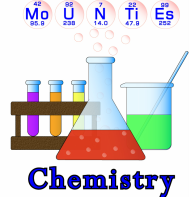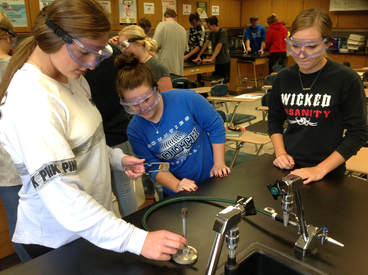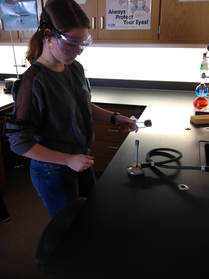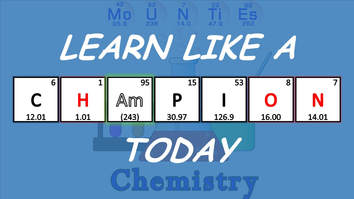|
Today we finished discussing the content of the Lab Equipment packet and reviewed the steps to operating a Bunsen Burner safely. Most classes had time remaining to go to the lab stations and practice with the burners. Tomorrow is the Lab Equipment Identification Test, as well as an opportunity to practice your Bunsen burner skills. If you would like to practice at home tonight, first download the ExamView Test Player Program using the link below, and also the Lab Equipment Review Question Pool Test Files...you may be asked to login to your Office365 account. Remember, it's your mounties.k12.pa.us email address to login:
Test Player Installers (Must install this first!) Lab Equipment Review Test File: Once downloaded, should be opened in the ExamView Test Player; presented in 10 question sets...fresh set each time you open the file.
Signed syllabus turned in. Wrapped up discussion of classroom expectations...most everything falls under the umbrella of "Respect". Began discussion of laboratory equipment, its identification and application. There will be a quiz on Friday which will focus primarily on visual identification, but also application type questions. You may use the following Quizlet deck: https://quizlet.com/_1i6ix8 to practice.
Homework: Please watch the following video on the Bunsen Burner to prepare for tomorrow's class:
Tomorrow we will finish going over the packet and have practice time with the Bunsen Burners.
Lab Safety Test was administered today and we continued our discussion of the syllabus/expectations.
Today we finished discussing the lab safety contract and passed out the class expectations/syllabus. Signed copy of the syllabus is due back on Wednesday, 9/5.
Don't forget to review your safety contract & the P.A.S.S. method for Tuesday's Lab Safety Test. Below is a refresher video on the P.A.S.S. method:
Watched the video "Lab Accident at Jefferson High" (see below) as an introduction to lab safety. There are questions embedded in the video towards the end that you can use to help you review for Tuesday's Safety Test.
After brainstorming individually on the question "What is Science?", we watched a diverse group of scientists from all different disciplines share their ideas of what science is. After reflecting on these thoughts and their own, students finished the following prompt: "Science is..."
Our next topic of discussion is laboratory safety, the most important rule of which deals with eye safety. To demonstrate the effect of an acid splash to the eyes, sulfuric acid was placed on cow eyes for different lengths of time to show the varying level of damage (play the video below for a synopsis of the demonstration and explanation). Bottom line...chemical damage begins to the eye immediately...it is imperative that you always wear your goggles and act immediately in an emergency.
Lab safety contracts were passed out today; signed copy is due back on Friday, 9/1...lab safety test will be given on Tuesday, 9/5.
Welcome to Chemistry! As we begin the new school year, we took a look at how we can come in each day and approach our mission this year in chemistry according to the motto: We can accomplish this by being ready to learn each day and also by working together collaboratively towards a common goal...developing a deeper, more relevant understanding of the world around us and how chemistry applies to it. We have a flipped classroom, which allows to use active learning methods in our face-to-face time...things like small-group team-based POGIL activities, guided practice exercises, and lab exercises. Today, we focused on why it's important to be able to work in teams. Give a common set of instructions, students found that they were both more confident and produced a better end-product when they worked as a team. The following links should allow you to download the ExamView Test Player Program, and also the Final Exam Review Question Pool Test Files...you may be asked to login to your Office365 account. Remember, it's your mounties.k12.pa.us email address to login: Test Player Installers (Must install this first!): https://mounties-my.sharepoint.com/personal/meisley_mounties_k12_pa_us/_layouts/15/guestaccess.aspx?guestaccesstoken=4kYKbJZzpJmYvox1whu8o%2bH%2f%2fra7x740AvsgN%2ba8qyI%3d&folderid=2_0065ad76c6a4543b7b86676d17b1f9e95&rev=1 Test Files: https://mounties-my.sharepoint.com/personal/meisley_mounties_k12_pa_us/_layouts/15/guestaccess.aspx?guestaccesstoken=3qcyWuSW%2fYTDMJa1bZ0%2bKOX1I6XtF4gAFLddTT81oSU%3d&folderid=2_0eccb3fa18f0246c481b3f700b0c86a39&rev=1
Note: If you were not in class yesterday (Wednesday), please get the companion handout from the front desk (Titration & Neutralization Calculations) and scroll down to the entry for Days 171-172 and complete that activity first.
Today you will review the process of titration and observe how the pH changes as a titration occurs; this is graphed with what is known as a titration curve. Check out the following link for a guided example of a titration & titration curve construction: Titration Guided Demonstration: http://www.mhhe.com/physsci/chemistry/animations/chang_7e_esp/crm3s5_5.swf After you work through the demonstration above, you will go to http://users.wfu.edu/ylwong/chem/titrationsimulator/index.html and complete 1 or more titration calculation samples. A video demonstrating how to carry out the titration, and what numbers to extract for your titration calculation, is shown below. Please watch the video for instructions on how to customize & interact with the simulation to self-check your work with titration calculations. (If the embedded video below does not show up/play, you will find the video on the Sample Drive in Eisley -> Video -> Solutions -> "Online Titration Simulation Demonstration"
Today's lesson is on a common laboratory analysis method known as titration. The video below will explain what titration is, how it is carried out, and the problem solving method used to solve titration/neutralization calculations. Play the video through, stopping after the 1st two worked examples; complete the 3rd example on your own, then finish the video to check your work.
|
This area will contain an overview of what was discussed/performed each day in class. Archives
October 2017
Categories |
Proudly powered by Weebly




 RSS Feed
RSS Feed